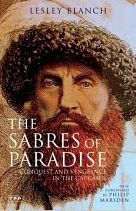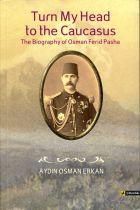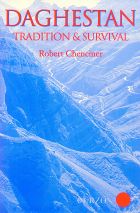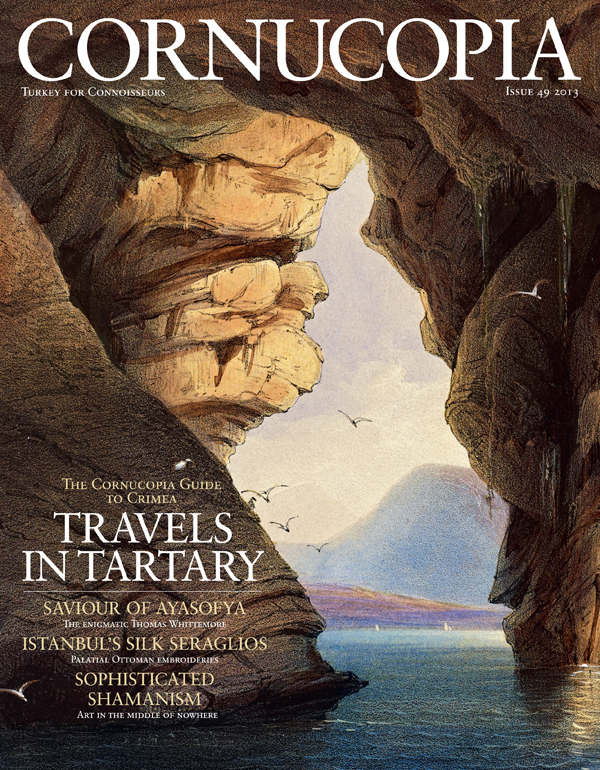Buy or gift a stand-alone digital subscription and get unlimited access to dozens of back issues for just £18.99 / $18.99 a year.
Please register at www.exacteditions.com/digital/cornucopia with your subscriber account number or contact subscriptions@cornucopia.net
Buy a digital subscription Go to the Digital EditionThe Russian love affair with the Caucasus has been long and cruel, though the outside world knows little of the multitude of ethnic groups who for millennia have inhabited this remote strip of land the size of France. In 2001, however, a remarkable catalogue was published. It reveals a unique collection of artefacts which for years have stood gathering dust in the vaults of a St Petersburg museum. Robert Chenciner examines the book and introduces a selection of its poignant photographs.
On Moscow television, the tired eyes and zombie gestures of the soon-to-die Chechen girl hostage-takers reflected a lost hopelessness that over the centuries has become a hallmark of the Caucasus. The promise of racial harmony within ethnic diversity in a region whose mountainous geography has cradled more than fifty languages has moved further away than ever. What irony that the repressive Soviet period marked one of the longest times of peace that the region has known during the past 2,500 years.
The Caucasus, briefly, is the corridor of land between the Black Sea and the Caspian Sea, dramatically cut off by two great parallel mountain chains. For centuries Byzantines from the west and Russians from the north vied with Persians from the south and Turkic peoples from the east to control the city of Derbent, which commanded the narrowest point of the passage along the Caspian Sea. Ancient Greeks, Romans, Sassanian Persians, Huns, Armenians, Khazars, Arabs, Vikings, Georgians, Mongols, Kıpçak Turks, Selçuk Turks, Ottomans, Safavids and Qajars have all left their mark.
Azerbaijan on the Caspian coast is a candidate for the biblical Garden of Eden. But perhaps it is the very natural riches of the Caucasus that have made it a prize for so many invading armies. Its handsome, vital and creative people survived mainly as warriors.
The musical, rhythmic name Kavkaz‚ or Caucasus‚ has no discovered origins. Herodotus mentioned the Caucasian Mountains in his History about 440BC. The “White”
Indo-European races were first called “Caucasian” in 1775 by the ethnographer Johann Blumenbach for no reason other than the great beauty of fair-skinned women of Circassia. Later the philologist Nikolas Marr followed a Romantic biblical interpretation that all mankind (and their languages) were descended “from the three sons of Noah”. In a facile way that of course has stuck, he put forward the notion that Japhet was the father of the “White Caucasian” peoples, in contrast to Ham for the “Black” and Shem for the “Semitic”.
For Russians, the Caucasus is a mythical place, their land of noble savages, their Wild West. It is also a source of huge ambivalence. As a recent splendid exhibition and catalogue show, fascination with the area led Russia to form the finest Caucasian ethnographic collection in the world. There is evident admiration in the painstaking and loving assembly of collections centred on these exotic peoples. The Ballets Russes were inspired by Caucasian dance. Caucasian music, cuisine and design have made their mark beyond Russia.
On the other hand Russia appears intent on laying waste to the region in a medieval spirit of destruction. Since the collapse of the USSR in 1991, she has provided the weapons, and often the military forces, for what has become a roll of disaster: Azerbaijan and Armenia; Georgia and Abkhazia and South Ossetia; North Ossetia and Ingushetia; and the two wars between Russia and Chechnya which have steadily sucked in Chechnya’s neighbours. The relationship seems to be redolent of the dark side of the human subconscious that makes us kill the thing we love.
To read the full, illustrated article buy the issue or read Cornucopia 28 online (subscribers only)
Few cities have been served so faithfully by an artist as Istanbul was served, in its twilight years as a great imperial capital, by Fausto Zonaro. By Philip Mansel
Carrots once came in a broad palette of hues – from white, cream and yellow, through pink and deep red to purple and black – as well as variegated versions of them all. Black carrots from the east of Turkey were famed for their medicinal properties.
More cookery features
Turkey’s Kaçkar Mountains, a daunting extension of the Caucasus high above the Black Sea, are only for the intrepid. Ali Özgü Caneri and Kate Clow took advantage of the short trekking season to scale two of the saw-edged summits. Photographs by Kate Clow.
Exiled by Stalin in 1929, Trotsky went to live on the Princes Islands near Istanbul. For four years he fished, wrote and developed the doctrine of Trotskyism. Remarkable photographs from the David King Collection show a quiet, ordered existence. Norman Stone uncovers the plotting that lay behind it.
Turkey’s northeastern neighbour, Georgia, is a fairytale country with a hard edge, and its entrancing landscape of isolated hilltop cathedrals and medieval monasteries just demands to be explored. By Minn Hogg
Built as way-stations for Orthodox pilgrims on their way to the Holy Land or Mount Athos, the rooftop churches of Karaköy are a forgotten corner of the Motherland in the heart of Istanbul. By Owen Matthews. Photographs by Simon Wheeler





Cornucopia works in partnership with the digital publishing platform Exact Editions to offer individual and institutional subscribers unlimited access to a searchable archive of fascinating back issues and every newly published issue. The digital edition of Cornucopia is available cross-platform on web, iOS and Android and offers a comprehensive search function, allowing the title’s cultural content to be delved into at the touch of a button.
Digital Subscription: £18.99 / $18.99 (1 year)
Subscribe now